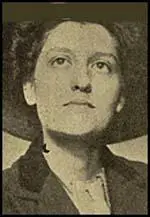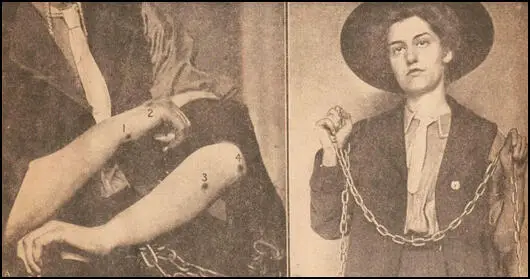Helen Fox

Helen Fox joined the Women's Freedom League (WFL) in November 1907. Other members included Charlotte Despard, Teresa Billington-Greig, Edith How-Martyn, Dora Marsden, Helena Normanton, Anne Cobden Sanderson, Muriel Matters, Octavia Lewin, Emma Sproson, Margaret Nevinson, Henria Williams and Violet Tillard. (1)
On 28th October 1908 Helen Fox and Muriel Matters organised a Women's Freedom League demonstration that would gain the maximum publicity. According to Margaret Nevinson, "an extra dull debate was going on when suddenly the bored audience was electrified at hearing a woman's voice, clear and very earnest, from the gilded cage, calling upon the Legislature to give justice and freedom to women." (2)
Officials rushed up the stairs to the ladies' gallery of the House of Commons, then enclosed from the rest of the chamber by a brass grille. Both women had chained themselves to the grille. Helen Fox delivered a speech she had prepared on the rights of women. Meanwhile the two-foot banner had descended on the end of the rope supports to within a few feet of the reporters' tables, where it flaunted itself in the faces of the Commons with the announcement that the 'Women's Freedom League demands votes for women this session.' (3)
When officials made attempts to remove them, it was discovered that they had chained and padlocked themselves to the grille in such a way that in order to remove them the grille would have to be removed as well. It took officials over ten minutes to wrest the grille from its supports. Once this was done "portions of the grille, which were carried behind the women to a committee room for the chains to be filed off." (4)
It has been argued that "While attached to the grille Matters, by a legal technicality, was judged to be on the floor of Parliament and thus, the words spoken by her that day are still considered to be the first delivered by a woman in the House of Commons." (5) The two women sat in a committee room until a locksmith was found to separate them from the thirty-foot long grille. (6)
Muriel Matters then went round to join the demonstration taking place in front of Parliament. They were shouting "votes for women" and yelling "Down with Liberal hypocrites" and Call yourself a Liberal". (7) Fifteen arrests were made including Muriel Matters, Violet Tillard, Alison Neilans, Arnold Cutler, Edith Bremer, Emily Duval, Margaret Henderson, Marion Leighfield. (8)

Primary Sources
(1) Exmouth Journal (31 October 1908)
Suffragettes cause of another scene in the House of Commons on Wednesday evenings. Two women chained themselves to the grille in front of the Ladies' Gallery, and a portion of the grille had to be removed by the police in order to release them…
Disturbances also occurred at the same time outside the House, leading to numerous arrests for disorderly conduct outside St. Stephen's Hall, and for attempting to harangue a throng at the base of the monument in front of the House of Lords. The two women who were the principal figures in the disturbances in the Ladies Gallery gave their names of Helen Fox and Muriel Matters…
No less than fifteen arrests were made in connection with the disturbances in St Stephen's Hall. They gave their names as follows: Arnold Cutler, Miss Violet Tillard, Miss Edith Bremer, Mrs. Emily Duval, Miss Margaret Henderson, Miss Alison Neilans, Miss Marion Leighfield… They were taken to Cannon Row Police Station, and were bailed out later.
(2) The Daily Mirror (30th October, 1908)
Miss Helen Fox, one of the two suffragettes who on Wednesday night chained themselves to the grille of the House of Commons Ladies Gallery, is the proud possessor of four honourable wounds gained in the cause of "women's suffrage". Contour map of Miss Fox's arms. (1) Bruise incurred by contact with chain. (2) Bruise from grille. (3) Accidental bruise during passage from gallery to street. (4) Bruise not so far accounted for.
(3) Edith How-Martyn, The Vote (30th December 1909)
In October of 1908 a deputation was sent to the House of Commons, and by taking the precaution of chaining themselves to the grille in the Ladies' Gallery Miss Muriel Matters and Miss Helen Fox were able to address the House of Commons for a few minutes without interruption. The attendants tore down portions of the grille, which were carried behind the women to a committee room for the chains to be filed off. At the same time a protest was made in the men's gallery and handbills thrown on the floor of the House, while further protests were made in St. Stephen's Hall and entrance. All the galleries of the House were closed to visitors, and only re-opened months later. Twelve members were sent to prison in the third division for a month.
(4) The Vote (24th June, 1911)
Forty thousand women's marching through London forty thousand women walking five abreast, with pennants flying abreast, with pennants flying, banners held aloft, colours of every hue and shade and gradation blazing in the sun; forty thousand women with faces to the dawn, women of every rank and party and creed and race and colour, women old and young, rich and poor; comrades all in the cause of freedom…
At half-past five the procession started from the Embankment and came swinging along at a good pace up Northumberland Avenue. The roads were packed with such dense crowds that in some parts the police had considerable difficulty in clearing a way for it…
The Police Court Protests banner, Marshalled by Miss Turner, and followed by fourteen members of the League, bore the words; "Legislation Without Representation is Slavery." Next to this was carried the Tax Resistance banner, showing that the Women's Freedom League initiated tax resistance in 1907.
The Grille Protest banner, depicting the grille and the chains, come next, followed by a large number of representatives of the famous protests marshalled by Mrs. De Vismes. The Picketers' banner bore the words: "729 hours were spent in Picketing the House of Commons to Exercise the Subjects Right of Petitioning the King's Ministers." The picketers made a brave show with their flying pennants of green, of gold, and of white. The Bermondsey Ballot-Box banner, which celebrated the ballot-box protest made by Mrs Chapin and Miss Alison Neilans, chronicled the fact that the protest was initiated in 1909 by the League.
(5) Margaret Nevinson, The Vote (24th August 1917)
At the end of the month (24 August 1917) some members of the Women's Freedom League made a protest in the House of Commons. An extra dull debate was going on when suddenly the bored audience was electrified at hearing a woman's voice, clear and very earnest, from the gilded cage, calling upon the Legislature to give justice and freedom to women. Officials and reporters rushed breathlessly up the stairs, and the former, after attempting to drag away by force Miss Muriel Matters and Miss Helen Fox who had chained themselves to the Grille, were obliged to cut down the barrier; and the two protestants, with about twenty square feet of grating attached to them, were conducted to one of the committee rooms, where the chain was sawn through. Subsequently Miss Matters and fourteen other women were arrested and sentenced to fines of £5 or one's month imprisonment in the third division.
(6) Hannah Louise Awcock, Turbulent Londoners: Muriel Matters (8th March, 2018)
Not one to rest on her laurels, on the 28th of October 1908 Muriel took part in a dramatic protest at the House of Parliament organised by the WFL. They were protesting against an iron grille in the Ladies' Gallery that obscured the view of the House of Commons and was seen as a symbol of women's oppression. Muriel and another activist called Helen Fox chained themselves to the offending grille, and loudly lectured the MPs below on the benefits of women's enfranchisement. The grille had to be removed so that a blacksmith could remove the two women. Released without charge, Muriel rejoined the protest outside the House of Commons, and was eventually arrested for trying to rush the lobby. The next day she was sentenced to one month in Holloway Prison.
Student Activities
References
(1) Martin Pugh, The Pankhursts (2001) page 167
(2) Margaret Nevinson, The Vote (24th August 1917)
(3) Sylvia Pankhurst, The History of the Women's Suffrage Movement (1931) pages 293-294
(4) Edith How-Martyn, The Vote (30th December 1909)
(5) Margaret Mulvihill, Charlotte Despard (1989) page 87
(6) Exmouth Journal (31 October 1908)
(7) Diane Atkinson, Rise Up, Women!: The Remarkable Lives of the Suffragettes (2018) page 123
(8) Fayette Gosse, Muriel Matters: Australian Dictionary of Biography (2006)

